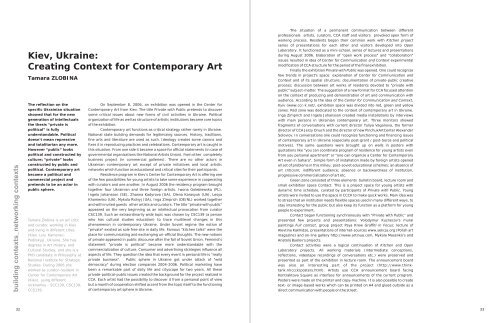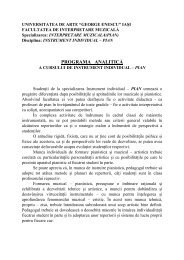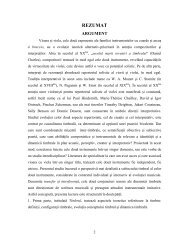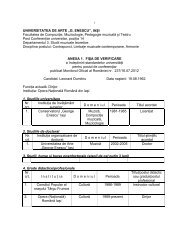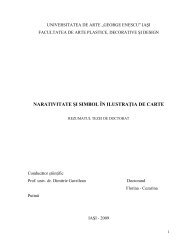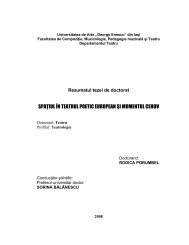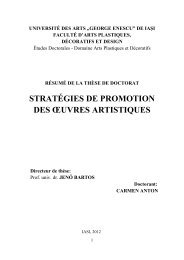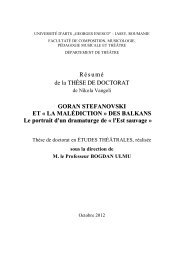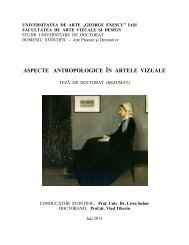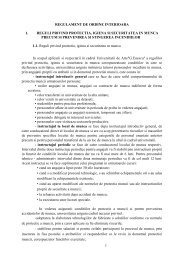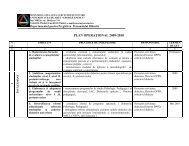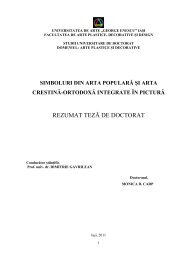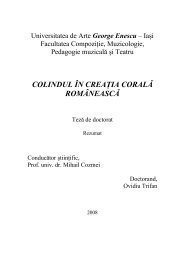vector 2_1.cdr - Universitatea de Arte "George Enescu"
vector 2_1.cdr - Universitatea de Arte "George Enescu"
vector 2_1.cdr - Universitatea de Arte "George Enescu"
You also want an ePaper? Increase the reach of your titles
YUMPU automatically turns print PDFs into web optimized ePapers that Google loves.
uilding contexts_networking contexts<br />
32<br />
Kiev, Ukraine:<br />
Creating Context for Contemporary Art<br />
Tamara ZLOBINA<br />
The reflection on the<br />
specific Ukrainian situation<br />
showed that for the new<br />
generation of intellectuals<br />
the thesis “private is<br />
political” is fully<br />
un<strong>de</strong>rstandable. Political<br />
doesn't mean repressive<br />
and totalitarian any more.<br />
However “public” looks<br />
political and constructed by<br />
culture; “private” looks<br />
constructed by public and<br />
political. Contemporary art<br />
became a political and<br />
commercial project and<br />
pretends to be an actor in<br />
public sphere.<br />
Tamara Zlobina is an art critic<br />
and curator, working in Kiev<br />
and living in different cities<br />
(Kiev, Lviv, Kamenec-<br />
Podilskyj), Ukraine. She has<br />
<strong>de</strong>grees in Art History, and<br />
Cultural Studies, and she is a<br />
PhD candidate in Philosophy at<br />
National Institute for Strategic<br />
Studies. During 2006 she<br />
worked as curator-resi<strong>de</strong>nt in<br />
Center for Contemporary Art<br />
(Kiev), using different<br />
nicknames - SCC139, CSC139,<br />
CCS139.<br />
On September 8, 2006, an exhibition was opened in the Center for<br />
Contemporary Art from Kiev. The title Private with Public pretends to discover<br />
some critical issues about new forms of civil activities in Ukraine. Political<br />
organization of life as well as structure of artistic institutions became core topics<br />
of the exhibition.<br />
Contemporary art functions as critical strategy rather rarely in Ukraine.<br />
National state building <strong>de</strong>mands for legitimizing sources. History, traditions,<br />
fine arts and literature are used as such. I<strong>de</strong>ology creates some canons and<br />
fixes it in reproducing practices and celebrations. Contemporary art is caught in<br />
this situation. From one si<strong>de</strong> it became a space for official statements (in case of<br />
governmental organizations like National Artists Union), from other completely<br />
business project (in commercial galleries). There are no other actors in<br />
Ukrainian contemporary art except of private initiatives and local artistic<br />
networks which function as educational and critical sites for their participants.<br />
Resi<strong>de</strong>nce program in Kiev's Center for Contemporary Art is offering one<br />
of the few possibilities for young artists to take some experience in cooperating<br />
with curators and one another. In August 2006 the resi<strong>de</strong>ncy program brought<br />
together four Ukrainian and three foreign artists. Iwona Golebiewska (PL),<br />
Ingela Johansson (SE), Zhanna Kadyrova (UA), Olena Karasyuk (UA), Lesya<br />
Khomenko (UA), Mykola Ridnyj (UA), Inga Zimprich (DE/NL) worked together<br />
and with invited guests other artists and curators. The title “private with public”<br />
appeared on the very beginning as an intellectual provocation from curator<br />
CSC139. Such an extraordinarily wi<strong>de</strong> topic was chosen by CSC139 (a person<br />
who has cultural studies education) to trace multilevel changes in this<br />
phenomenon in contemporary Ukraine. Un<strong>de</strong>r Soviet regime the notion of<br />
"private" existed as sole free site in daily life. Famous "kitchen talks" were the<br />
place for communicating and exchanging un-official thoughts. The new notions<br />
of private appeared in public discourse after the fall of Soviet Union. Feminist's<br />
statement "private is political" became more un<strong>de</strong>rstandable with the<br />
commercialization of culture. Consumer and advertising strategies influence all<br />
aspects of life. They question the i<strong>de</strong>a that every event in personal life is "really<br />
private business". Public sphere in Ukraine got un<strong>de</strong>r attack of "wild<br />
<strong>de</strong>mocracy" during election companies 2004-2006. Political marketing have<br />
been a remarkable part of daily life and cityscape for two years. All these<br />
private-political-public issues created the background for the project realized in<br />
CCA. Each artist had the possibility to discover it from a personal point of view<br />
but a month of cooperation shifted accent from the topic itself to the functioning<br />
of contemporary art sphere in Ukraine.<br />
The situation of a permanent communication between different<br />
professionals artists, curators, CCA staff and visitors provoked open form of<br />
working process. Resi<strong>de</strong>nts began their common work with Kitchen project<br />
series of presentations for each other and visitors <strong>de</strong>veloped into Open<br />
Laboratory. It functioned as a mini-school, series of lectures and presentations<br />
during August 2006. Elaboration of "open work process" and "collaboration"<br />
issues resulted in i<strong>de</strong>a of Center for Communication and Context experimental<br />
modification of CCA structure for the period of the final exhibition.<br />
Finally the exhibition Private with Public was opened. One could recognize<br />
few trends in project's space: explanation of Center for Communication and<br />
Context and of its spatial structure; documentation of private-public creative<br />
process; discussion between art works of resi<strong>de</strong>nts <strong>de</strong>voted to "private with<br />
public" subject-matter. The suggestion of a new format for CCA focused attention<br />
on the context of producing and <strong>de</strong>monstration of art and communication with<br />
audience. According to the i<strong>de</strong>a of the Center for Communication and Context,<br />
Kyiv (www.ccc-k.net), exhibition space was divi<strong>de</strong>d into red, green and yellow<br />
zones. Red zone was <strong>de</strong>dicated to the context of contemporary art in Ukraine.<br />
Inga Zimprich and Ingela Johansson created media installations by interviews<br />
with main persons in Ukrainian contemporary art. Three monitors showed<br />
fragments of conversations with current director Yuliya Vaganova, the former<br />
director of CCA Jerzy Onuch and the director of new PinchukArtCenter Alexan<strong>de</strong>r<br />
Soloviov. In conversations one could recognize functioning and financing issues<br />
of contemporary art in Ukraine (especially post-grant / post-Soros and political<br />
motives). The same questions were brought up on walls in posters with<br />
quotations like "you can coordinate program of resi<strong>de</strong>nce for young artists even<br />
from you personal apartment" or "one can organize a Center for Contemporary<br />
Art even in Sahara". Simple form of installation ma<strong>de</strong> by foreign artists opened<br />
all set of problems in this milieu: post-soviet educational schemes; an absence of<br />
art criticism; indifferent audience; absence or backwardness of institution,<br />
progressive commercialization of art etc.<br />
Green zone consisted of three elements bulletin board, lecture room and<br />
small exhibition space Contact. This is a project space for young artists with<br />
dynamic time schedule, curated by participants of Private with Public. Young<br />
artists were invited to use the space in CCCK to make quick works. Main i<strong>de</strong>a was<br />
to stress that an institution needs flexible spaces used in many different ways, to<br />
stay interesting for the public but also keep its function as a platform for young<br />
people to experiment.<br />
Contact began functioning synchronously with “Private with Public” and<br />
presented few projects and presentations: Volodymyr Kuznecov's mural<br />
paintings Full contact, group project Psya Krew Graffiti in Focus; lecture of<br />
Alevtina Kakhidze, presentations of internet-sources www.sekcja.org (Polish art<br />
magazine) and on-line gallery http://www.artinua.com, Mykola Masenko's and<br />
Anatolij Byelov's projects.<br />
Contact activities were a logical continuation of Kitchen and Open<br />
Laboratory projects. All working materials (intermediate conceptions,<br />
reflections, vi<strong>de</strong>otape recordings of conversations etc.) were preserved and<br />
presented as part of the exhibition in lecture room. The announcement board<br />
was also an interesting part of the project (http://www.thinktank.nl/ccck/posters.html).<br />
Artists use CCA announcement board facing<br />
Kontraktova Square as interface for announcements of the current program.<br />
Posters were ma<strong>de</strong> on the printer and copy-machine. It is also possible to create<br />
text- or image-based works which can be printed on A4 and glued outsi<strong>de</strong> as a<br />
direct communication with people on the street.<br />
33


